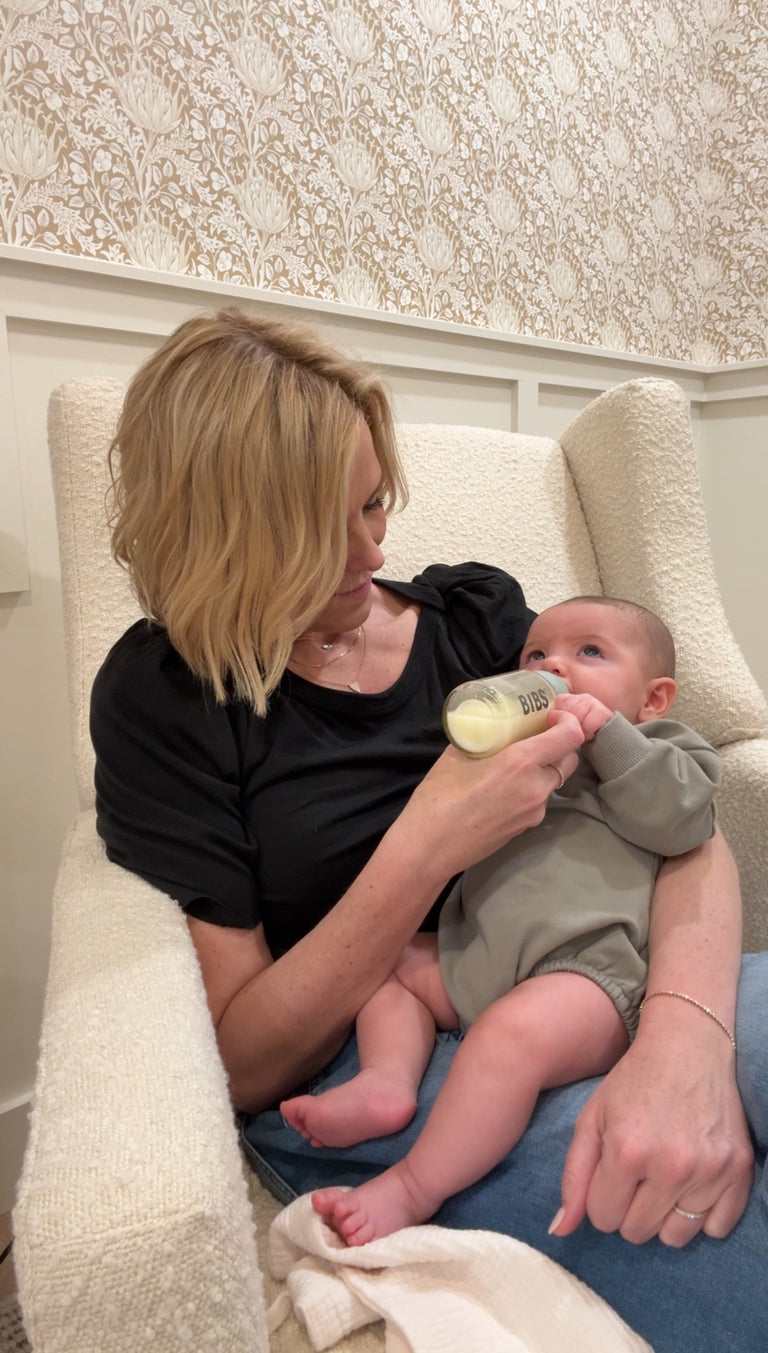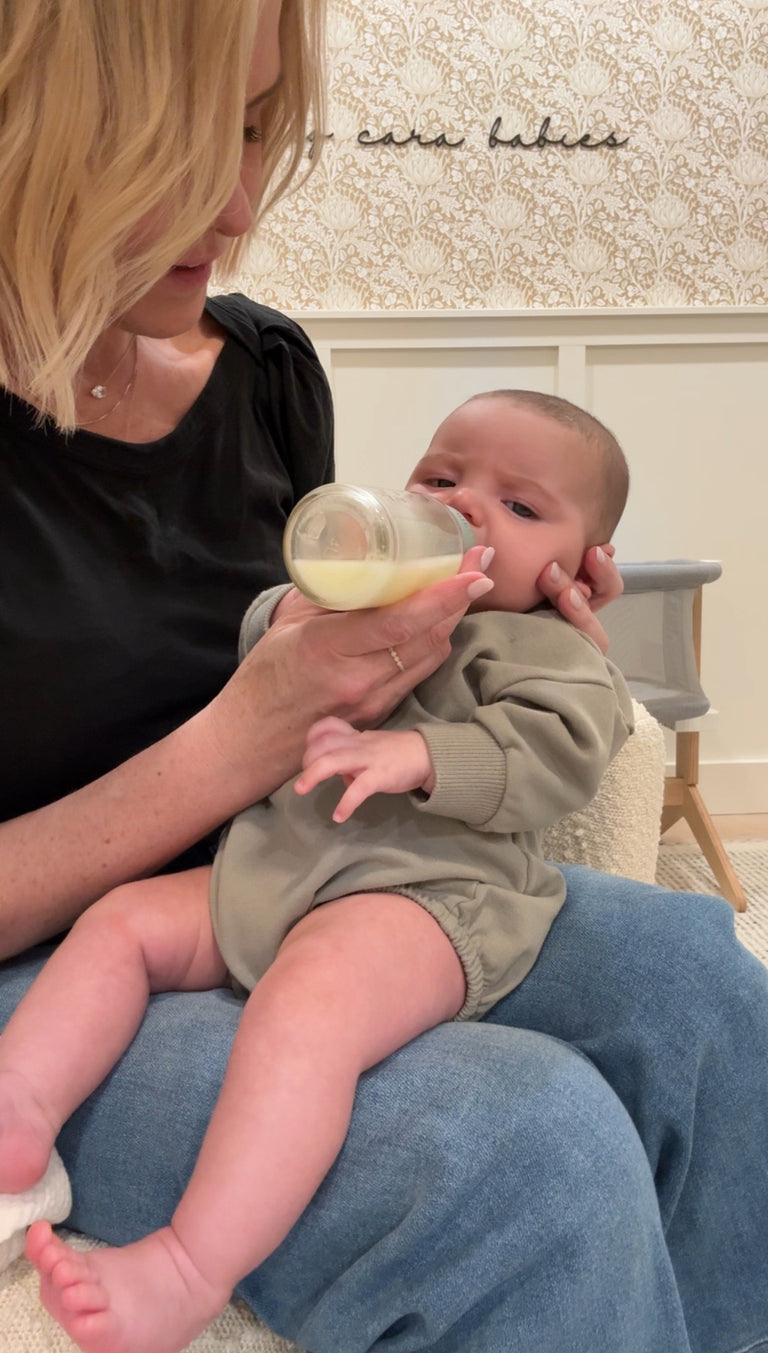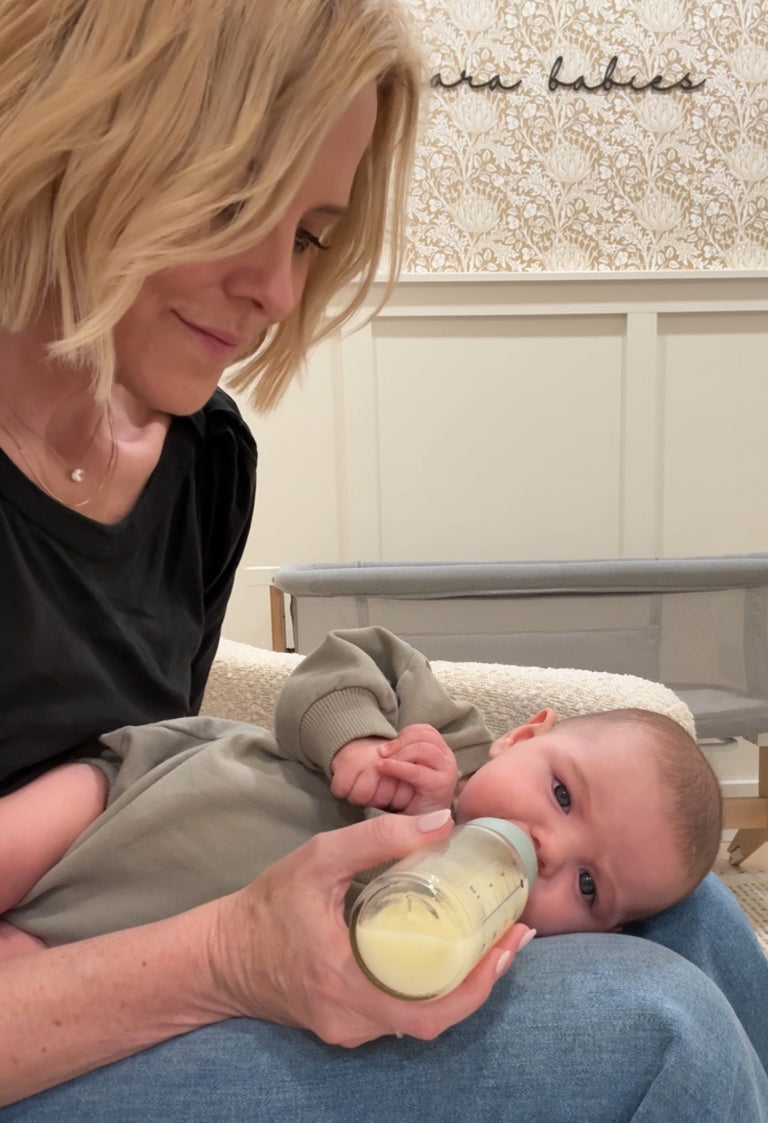Whether you’re planning to use formula or breast milk in the bottle, let’s cover bottle feeding 101, including how paced bottle feeding works, different bottle feeding positions, and when to stop bottle feeding.
If you need help choosing a baby bottle or knowing how to prepare a bottle, be sure to check out Bottle Feeding 101: How to Choose and Prepare Bottles.
How to introduce a bottle to your baby:
1. Know how to position the bottle in your baby's mouth.
When offering the bottle to your baby, point the nipple toward the roof of your baby’s mouth, specifically between the hard and soft palate. This is the area that helps stimulate your baby’s sucking reflex. To locate this spot, feel the roof of your own mouth and slide your finger back until you find where it transitions from hard to soft. Feel it? This is the sweet spot where the nipple should be positioned for optimal sucking.
If you insert the nipple straight back, your baby will likely gag. If you put the nipple on the tip of their tongue, they will thrust it forward (spit it out). Don’t let this scare you or make you think your baby is telling you they don’t want it. Both of these are reflexes — the gag and tongue thrust. Your baby is supposed to do this! Instead of stimulating the gag reflex or tongue thrust reflex, we want to stimulate the sucking reflex so insert the nipple toward the roof of baby’s mouth.
Expert Tip: If your baby doesn't immediately start sucking, that’s okay! Hold the bottle firmly, but gently in place while applying some light pressure to the roof of your baby’s mouth. Then, wait for sucking.
2. Regulate the flow.
Once your baby starts sucking, hold the bottle parallel to the floor rather than titling it upward. Keeping the bottle parallel to the floor allows your baby to regulate the milk flow. Watch for signs that the flow is too quick or too slow. If the flow is too quick, you might see your baby gulping, coughing, milk spilling from their mouth, or them unlatching and turning their head. If the flow is too slow, you might notice fussiness, irritation, or even that the nipple collapses as your baby tries to feed.
If your baby is struggling with the bottle, here are some things to consider:
Change up the nipple. If your baby is struggling with the bottle that you’re using, try different nipple shapes and brands.
Adjust the temperature. If warmer milk isn't working, try cooler milk.
Use a different position. You can face your baby outward and offer the bottle when they are in more of a vertical position. Feel free to walk around as you’re offering it. Another option is to try it while they’re lying on their side in your lap. (Again, keep the bottle parallel to the floor.)
Important Note: If your baby is exclusively formula-fed and struggling with feeding, please be sure to reach out to your pediatrician. They can help you problem-solve, be sure that your baby is getting the calories they need, and point you in the direction of a feeding specialist in your area.
3. For nursing babies, offer the bottle daily starting at about 4-5 weeks.
If your baby is nursing and bottle feeding, offer the bottle at least once a day (starting at about 4-5 weeks). Offering it daily will help your baby become accustomed to the bottle without creating unnecessary stress for either of you.
Expert Tip: It’s important to keep in mind that offering the bottle doesn’t necessarily need to replace a full feeding. It can, but it doesn’t have to! Even just an ounce each day is enough to remind your baby of the skill and reinforce their comfort with the bottle. By doing this consistently, you help your baby maintain familiarity with bottle feeding while still preserving your nursing routine. Over time, as your baby becomes more comfortable with the bottle, you can gradually increase the amount offered.
What are the most common bottle-feeding positions?
It’s important to find a bottle-feeding position that is comfortable for both you and your baby. The most common bottle-feeding positions are:
Cradle hold. This is likely what you imagine when you think of holding and feeding your baby. In the cradle hold, your baby’s head rests in the crease of your bent arm while your forearm supports their back. The arm not holding the baby will be holding the bottle. Here’s an example:
Image gallery
Seated upright. In a seated upright feeding position, your baby will be “seated” on your leg with their head supported by your arm or upper body. For newborns and young babies, you will use your non-bottle holding hand to ensure your baby’s head and neck are properly supported. Being upright in this position is especially helpful for babies with reflux. Here’s an example:
Image gallery
Laying on your lap. Sit with your legs together and place your baby on their side on top of your legs. You’ll use one hand behind their head to keep them stable and the other hand to hold the bottle. This position mimics breastfeeding, and helps your baby get a slower, more controlled flow of milk from the bottle. Here’s an example:
Image gallery
What is paced bottle feeding?
Paced feeding is a way to slow down, or “pace,” your baby’s bottle feeding. The goal is to slow the feeding down and encourage your baby to actively suck in order to get milk (instead of the milk pouring out of the bottle into their mouth). Paced feedings are often used for babies who:
Feed too quickly, resulting in excess gas or tummy upset
Breastfed babies who are used to slower feedings
Breastfed babies who are showing signs of bottle preference
Let’s walk through exactly how to offer a paced bottle feeding to your little one:
Use a slow-flow nipple on the bottle.
Find a comfortable feeding position for you and your baby.
Hold the bottle parallel to the ground, not tilted upwards.
Ensure the nipple is not full of milk.
Be aware of your baby’s natural break/pause in feeding, and gently pull the nipple out.
Allow your baby to initiate the feeding by pulling the bottle nipple into their mouth, as opposed to forcing their mouth open to feed.
What if my baby won’t take a bottle?
Bottle refusal can be very stressful for a parent. If your baby won’t take a bottle, here are a few things to assess and try:
Experiment with different bottle/nipple options. Try a variety of bottle brands and different nipple flows. Sometimes it takes a few tries before finding the right bottle for your little one. You can also experiment with different feeding positions.
Change up the timing. Offer the bottle when your baby is nearing their next feeding time but not so hungry they are upset. Offer the bottle when they are waking up from a nap and still a little sleepy.
Be patient, but persistent. If a bottle is new for your baby, it’s normal to have an adjustment period. We don’t want the bottle to become a negative experience. So if the bottle attempt is leading to tears and frustration, it’s okay to stop and try again later.
Seek help. Have a discussion with your care team to discuss other options for helping your little one.
If your baby is refusing a bottle and there are no other feeding methods available to you at the moment, please reach out to your child’s pediatrician right away. They can walk you through the best next step for your family.
Does a bottle help babies sleep longer?
No, research doesn’t support any difference in sleep between well-fed babies who are nursing or bottle feeding.
If you need help getting longer stretches of sleep at night for your newborn or baby, I have classes to help! My Newborn Sleep Bundle will walk you through how to lay a strong sleep foundation for your newborn. I’ll teach you how to set up your days to have more successful nights. Have an older baby? My 5–24 Month Collection will give you a step-by-step plan to 10-12 hour nights in the crib. I’ll cover bedtime, night wakings, night weaning, and naps through the first two years of life.
When to stop bottle-feeding
According to the AAP (3), children should be fully transitioned from a bottle to a cup between 12 and 24 months. By about 12 months, most babies have the physical and developmental skills they need to hold and drink from a cup, so that’s a great time to begin the transition to a cup.










